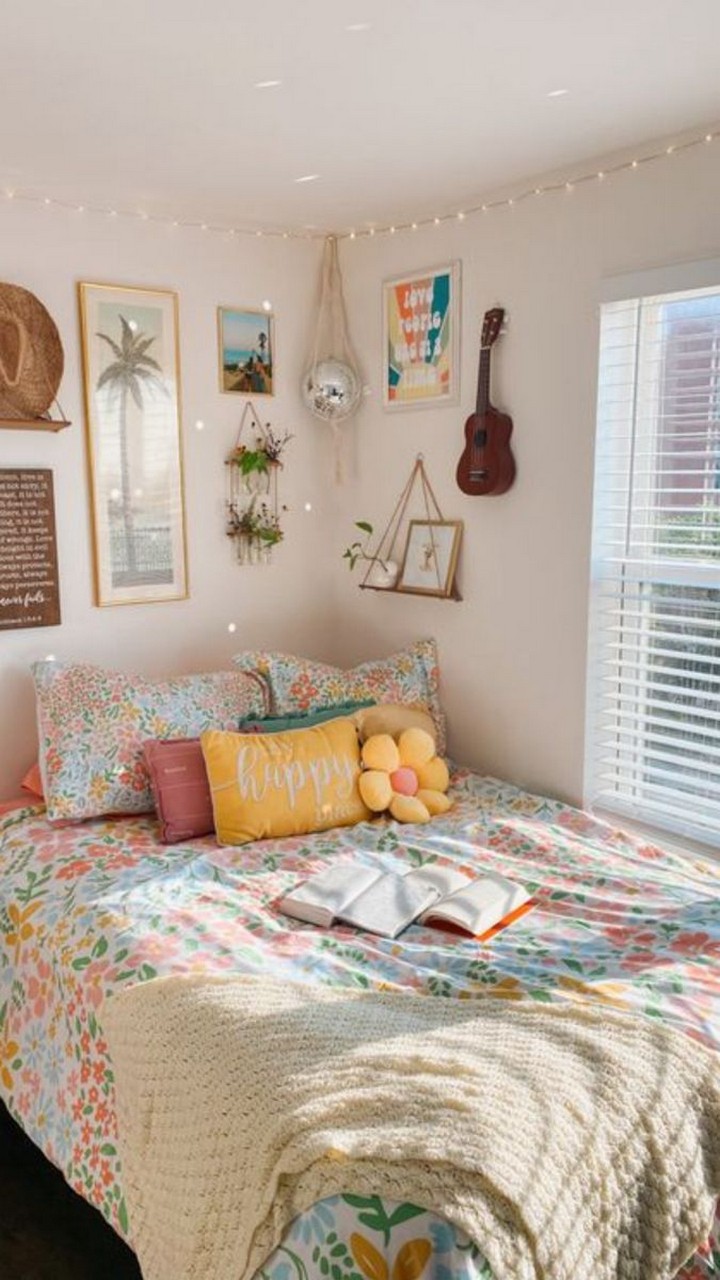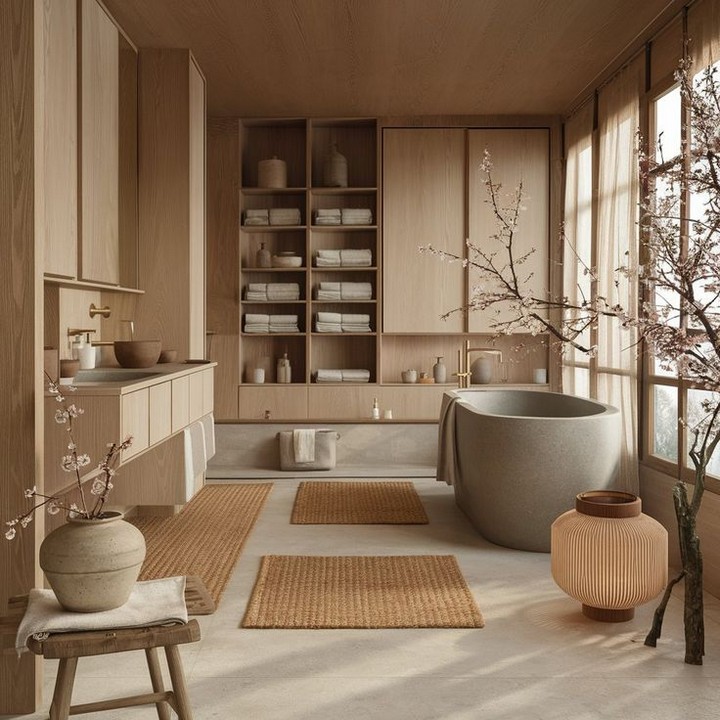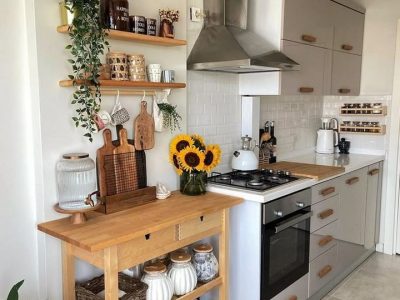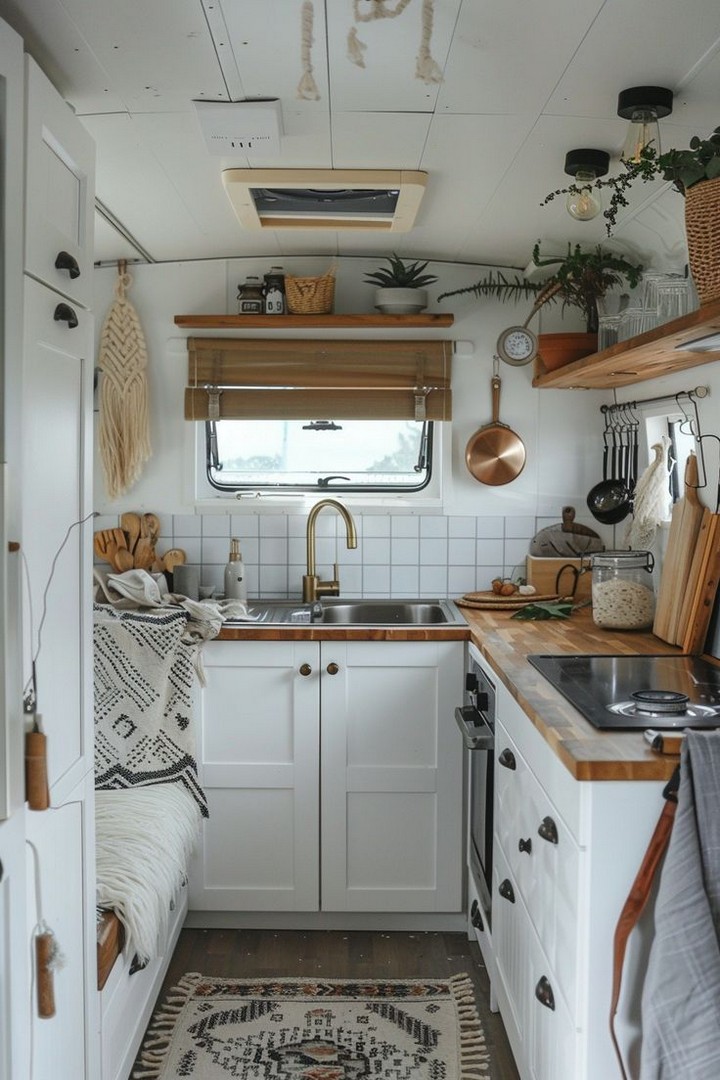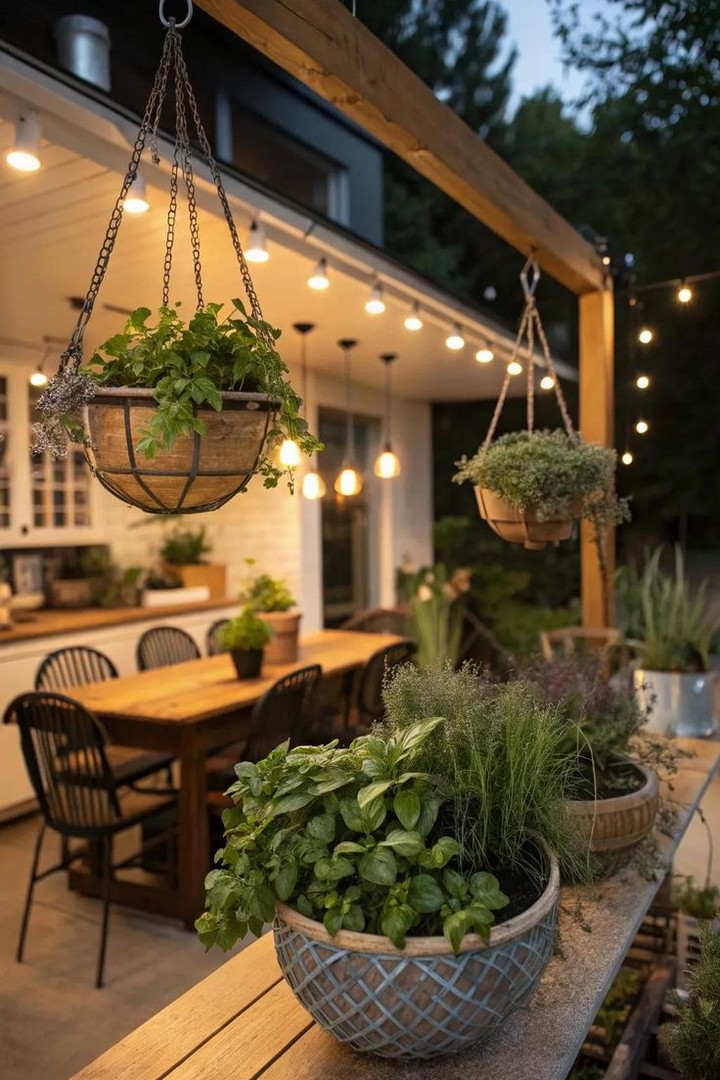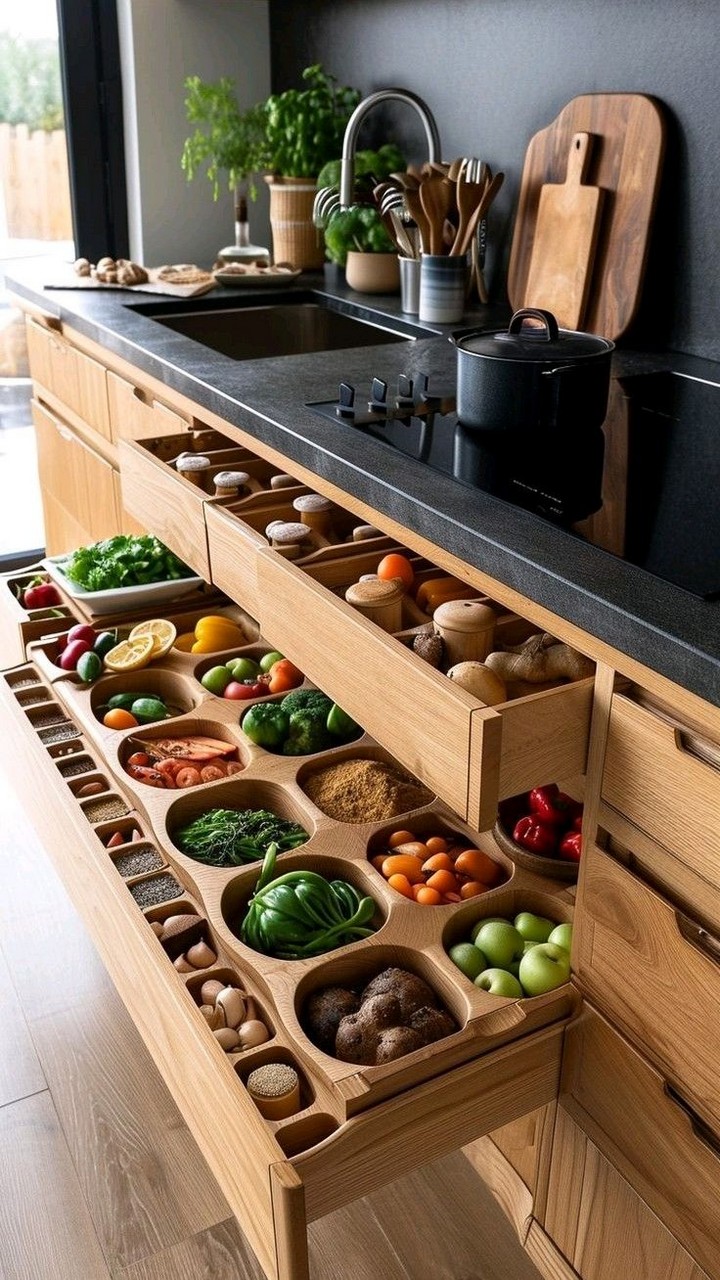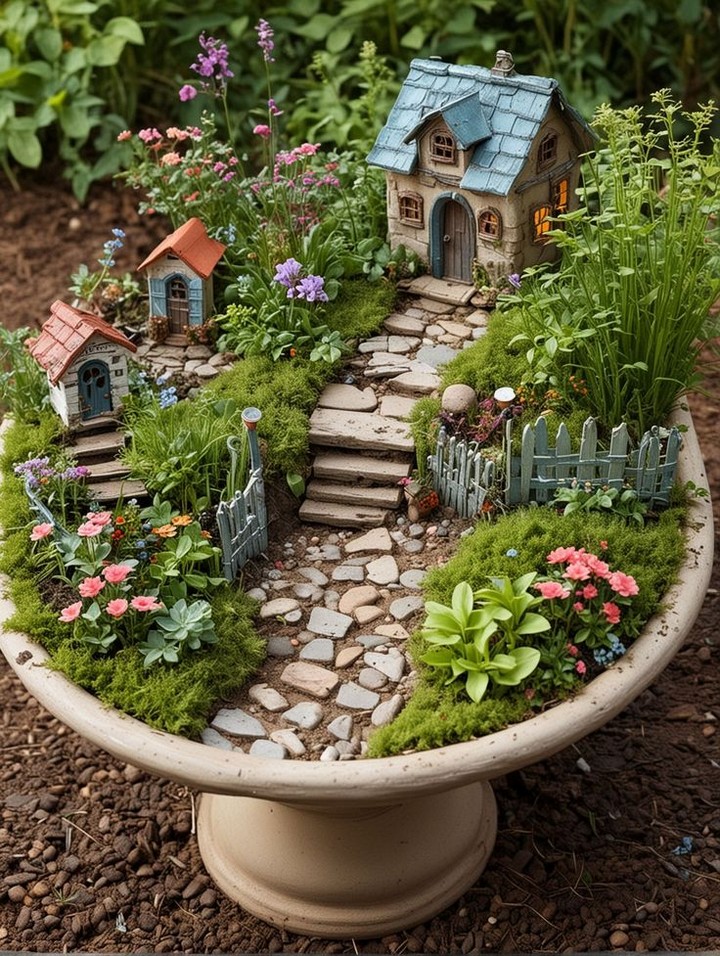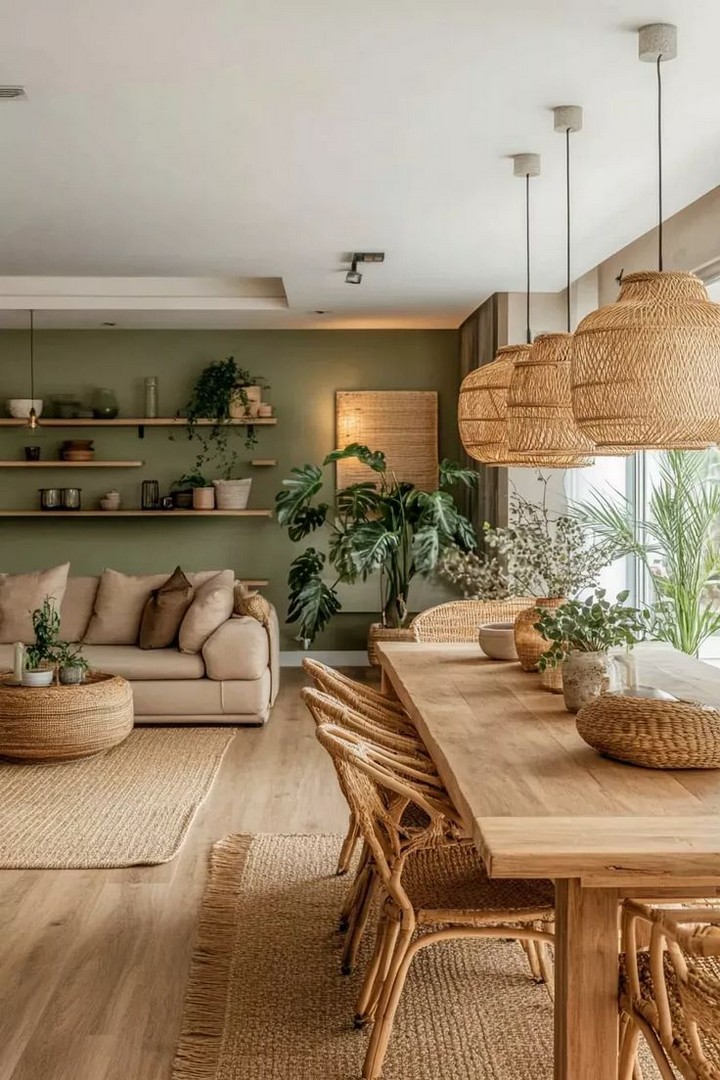How do you fit all the functionality of a full-sized cooking space into a fraction of the square footage? As tiny houses continue gaining popularity among minimalists, environmental enthusiasts, and those seeking financial freedom, innovative tiny house kitchen designs have emerged that prove you don’t need expansive countertops and walk-in pantries to create a functional, beautiful cooking space.
Whether you’re planning your own tiny house build, renovating a compact apartment kitchen, or simply fascinated by space-efficient design, these 28 tiny house kitchen ideas demonstrate how thoughtful planning and creative solutions can transform even the smallest spaces into culinary havens. From vertical storage solutions to multi-functional fixtures, these approaches maximize both functionality and style without sacrificing the joy of cooking.
Space-Maximizing Layout Strategies
1. The Galley Configuration
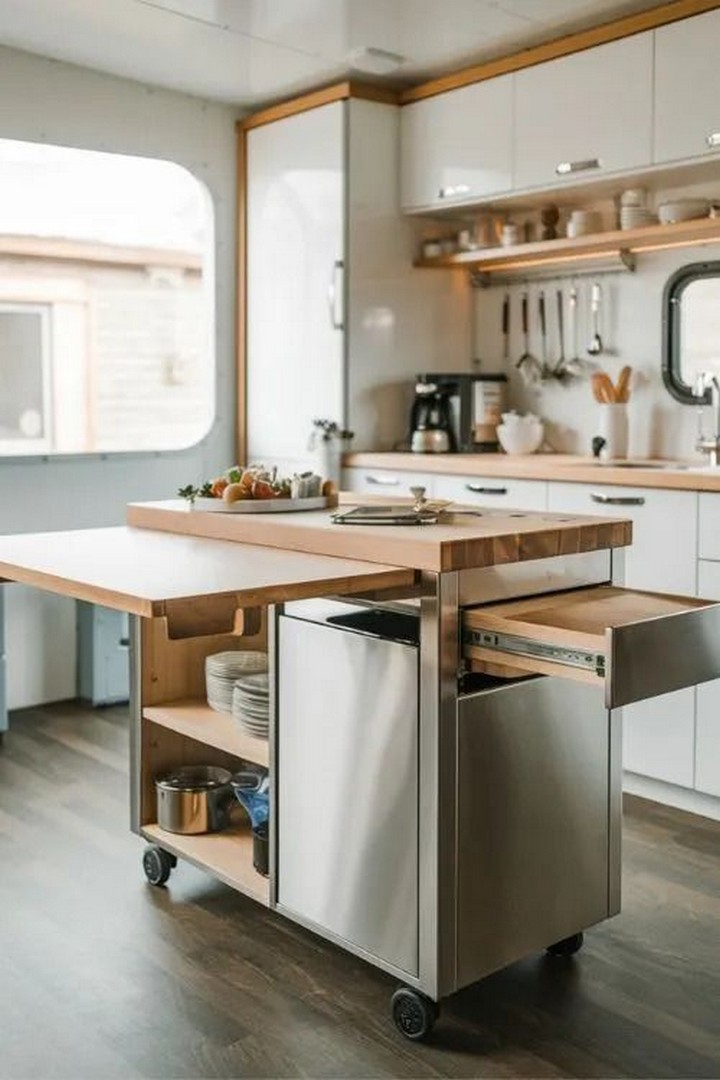
The galley layout featuring parallel countertops with a walkway between remains the gold standard for tiny house kitchens. This configuration maximizes counter space while keeping everything within easy reach. In the most successful tiny house galley kitchens, one side often incorporates major appliances while the opposite wall features prep space and storage.
For enhanced functionality, consider a galley width of 36-42 inches narrow enough to conserve space but wide enough to work comfortably. Some clever tiny house designers incorporate sliding countertop extensions that can be tucked away when not in use, providing additional workspace for more elaborate meal preparation.
2. L-Shaped Corner Utilization
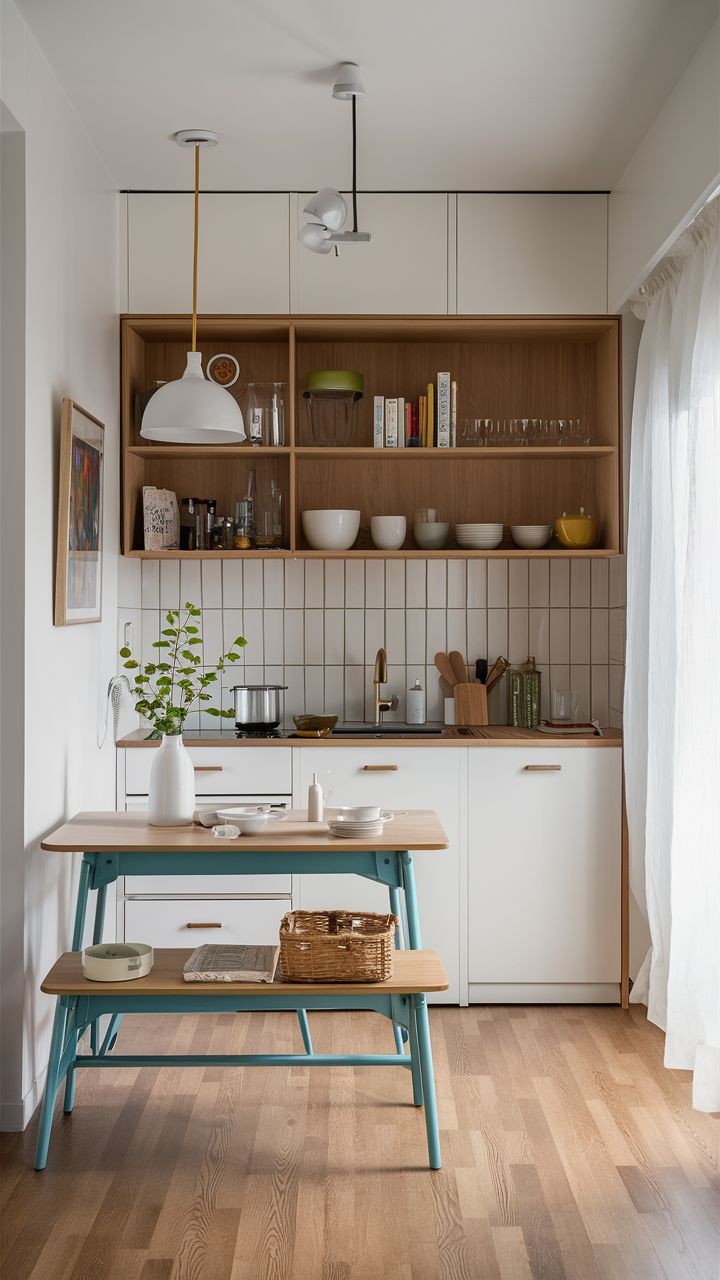
Corner spaces offer valuable real estate in tiny kitchens. An L-shaped layout makes efficient use of corners while creating a natural workflow. This configuration works particularly well in tiny houses with the kitchen positioned at one end of the structure.
To maximize an L-shaped tiny kitchen, incorporate corner solutions like rotating carousel shelves or pull-out corner drawers that make those otherwise awkward spaces fully accessible. Some innovative designs feature corner sinks that fit diagonally into the angle, preserving precious counter space on both adjoining walls.
3. Single-Wall Efficiency
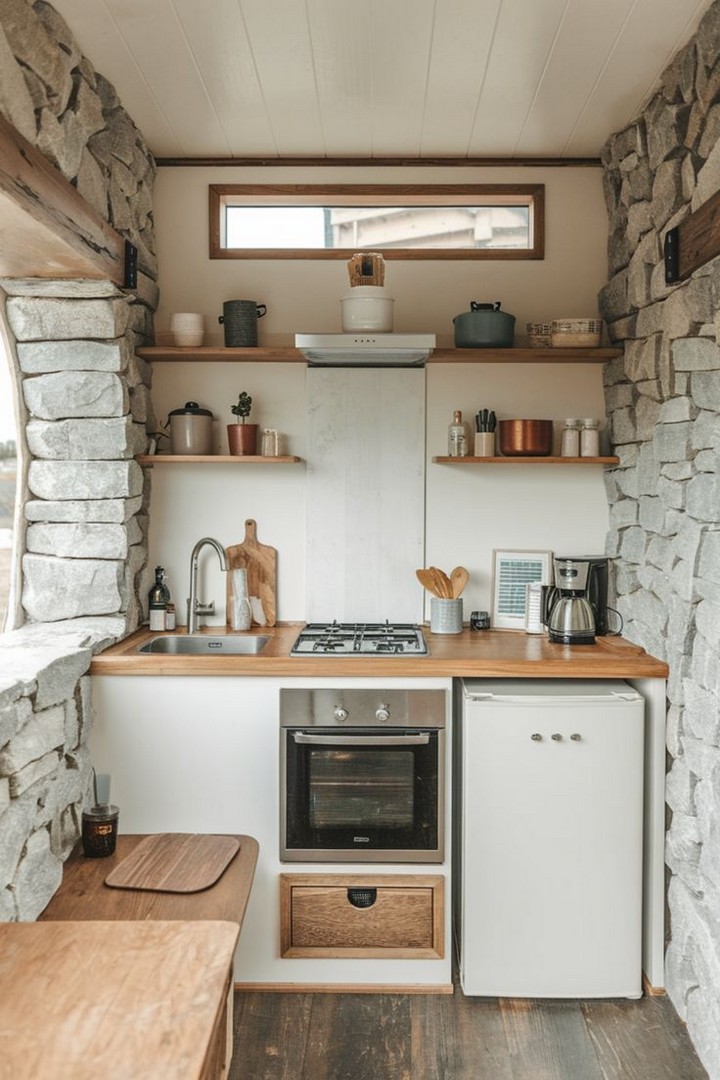
For the smallest tiny homes, a single-wall kitchen layout offers maximum space efficiency. This design places all components storage, appliances, sink, and prep areas—against one wall, leaving the opposite space open for living functions.
The key to successful single-wall tiny kitchens lies in vertical organization and careful component sequencing. Following the classic work triangle principle, even in linear form, can create an ergonomic cooking space. Consider placing the refrigerator at one end, the sink in the middle, and the cooktop at the other end to create a natural workflow.
4. Kitchen Islands on Wheels
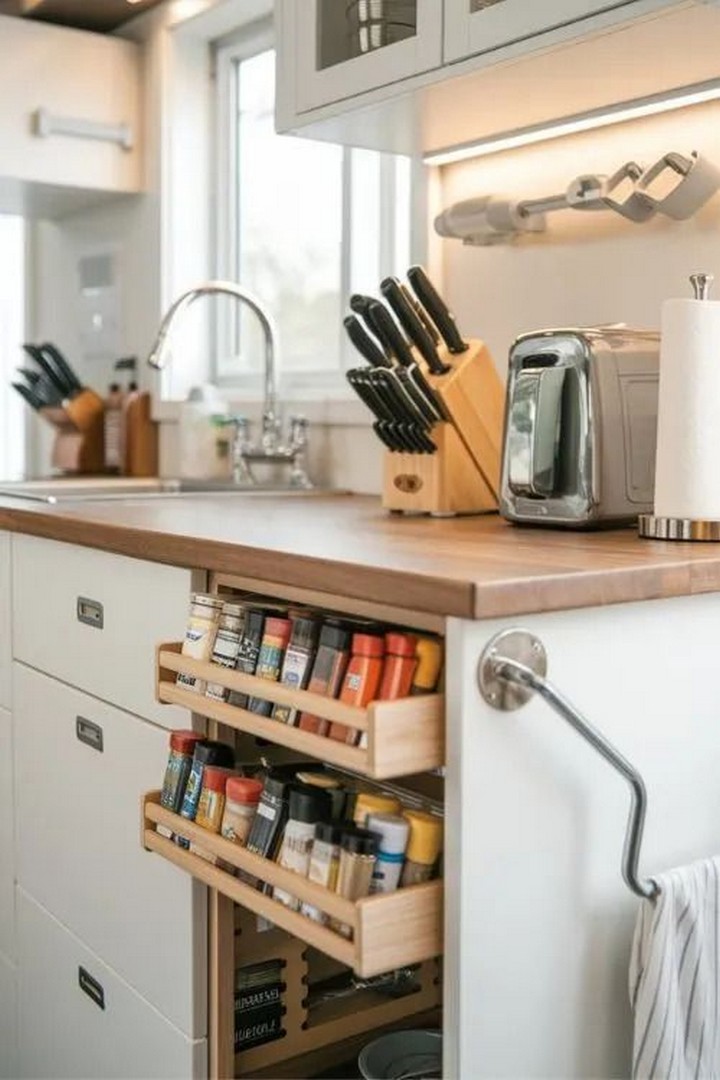
Portable kitchen islands offer game-changing flexibility in tiny house design. These movable workstations provide additional counter space when needed and can be repositioned or completely tucked away when not in use.
For maximum functionality, look for rolling islands with built-in storage, drop-leaf extensions, and locking casters for stability during use. Some ingenious tiny house dwellers use islands that double as dining tables or work stations, truly embodying the multifunctional philosophy that defines successful tiny living.
Smart Appliance Solutions
5. Combination Appliances
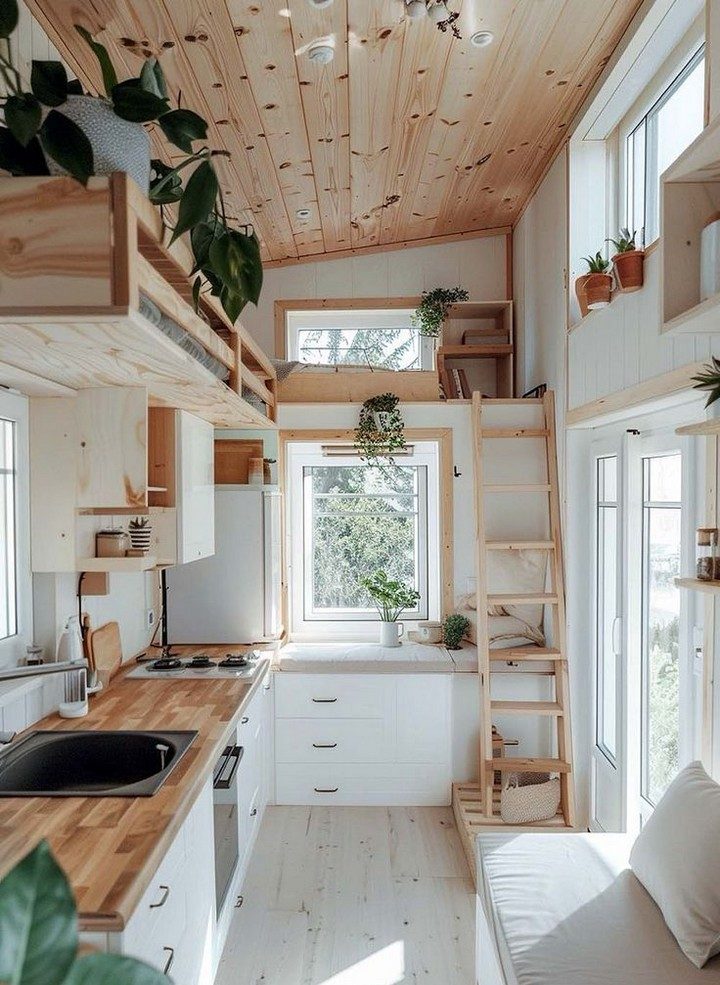
Combination appliances offer tremendous space-saving potential in tiny kitchens. Consider options like microwave-convection oven combos, which provide multiple cooking methods in a single unit. For those who enjoy baking, some compact ranges now include conventional oven functions, convection features, and cooktop burners in footprints significantly smaller than standard appliances.
The latest innovations include multi-cooking appliances that combine pressure cooking, air frying, slow cooking, and more in counter-sized units. When every inch counts, these versatile tools eliminate the need for multiple single-function devices.
6. Apartment-Sized Refrigeration
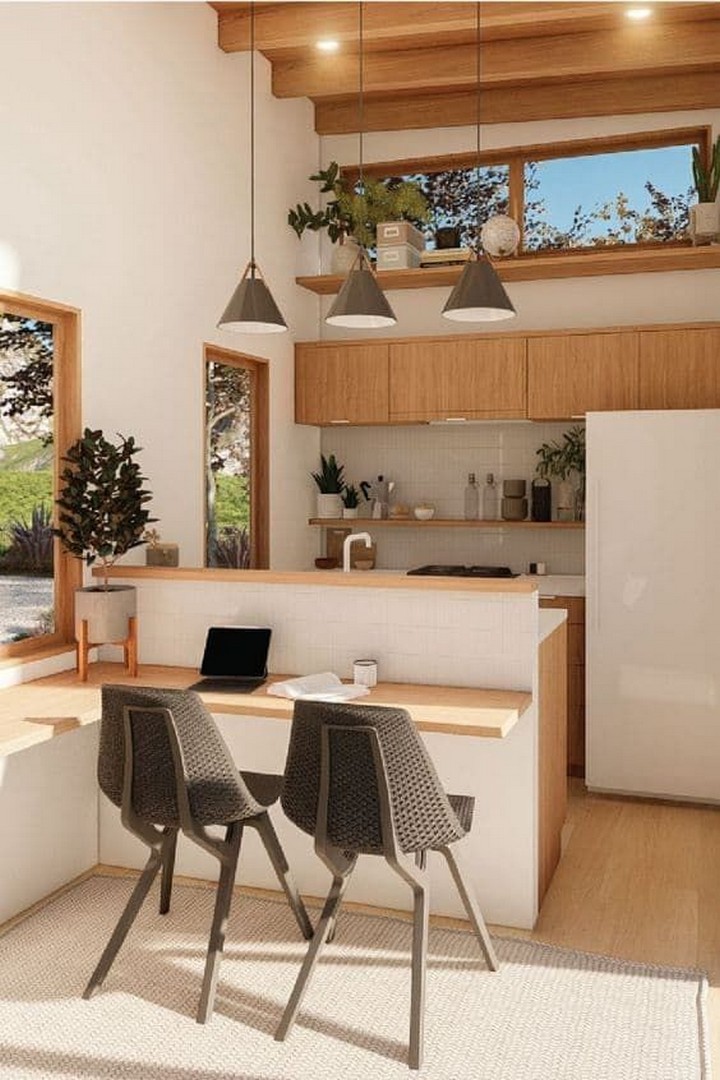
Full-sized refrigerators rarely make sense in tiny house kitchens. Instead, apartment-sized refrigerators (typically 7-10 cubic feet) offer sufficient storage while conserving precious floor space. For even greater efficiency, consider drawer refrigerators that can be installed under countertops, preserving wall space for storage.
Some tiny house dwellers opt for separate mini-refrigerator and freezer units placed in different areas, distributing the cooling functions where they make most sense—perhaps with refrigerated items near the prep area and frozen items in less accessible space.
7. Two-Burner Cooktops
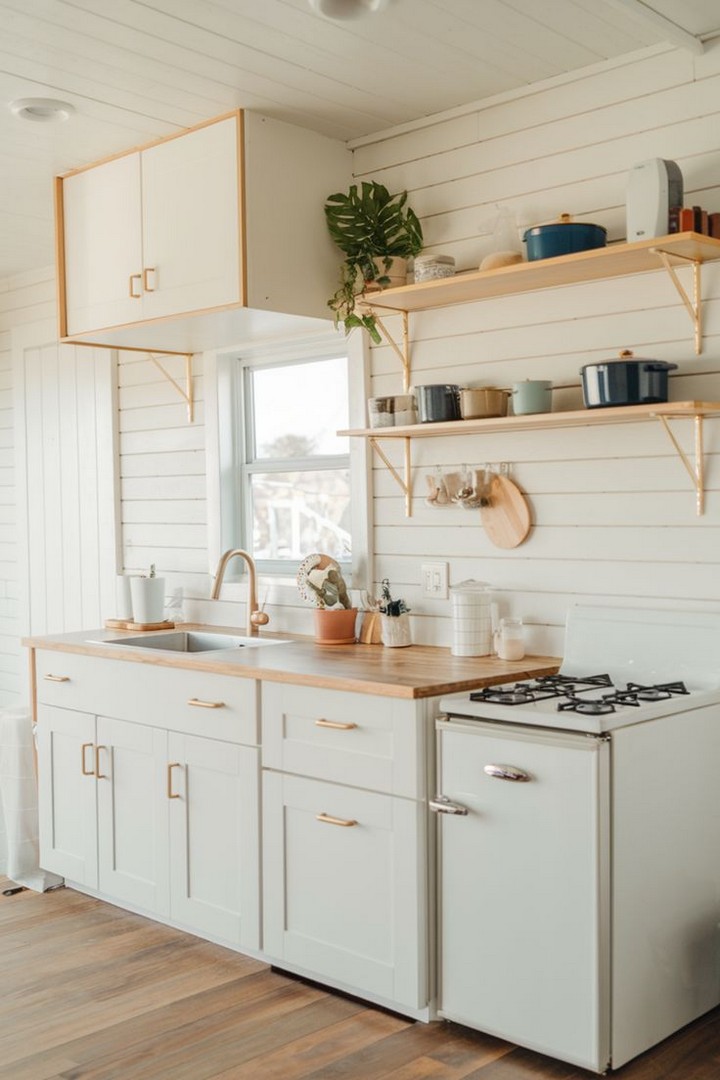
Four-burner ranges are rarely necessary in tiny house cooking. Streamlined two-burner induction cooktops provide ample cooking capacity while minimizing space requirements. These efficient cooking surfaces heat quickly, cool rapidly, and can be installed with minimal clearance requirements due to their safety features.
For those seeking maximum flexibility, portable induction burners can be stored when not in use, freeing up counter space for other functions. Some tiny house kitchens incorporate a combination of a single built-in burner plus a portable unit that can be used when preparing more complex meals.
8. Compact Ventilation Solutions
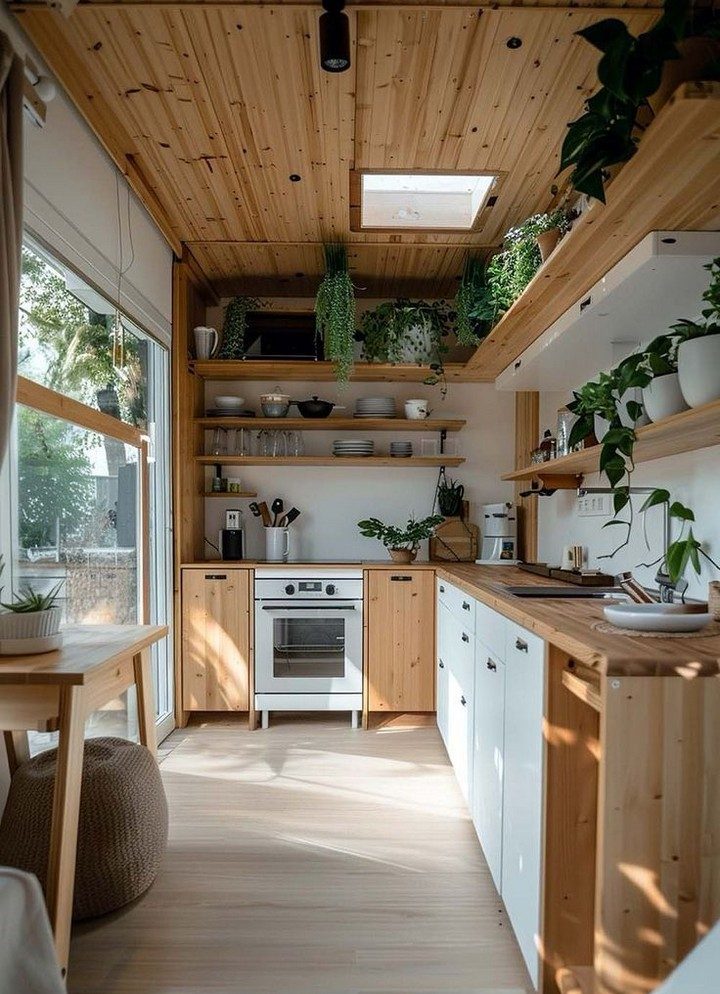
Proper ventilation remains essential even in the smallest kitchens. Recirculating range hoods offer space-efficient solutions that filter cooking odors and grease without requiring exterior ducting—a significant advantage for tiny houses where wall space is precious.
For an even more minimal approach, some tiny kitchens incorporate ceiling exhaust fans positioned strategically above cooking areas, combined with windows that can be opened during cooking sessions. The most innovative tiny house designs feature motorized clerestory windows that automatically open when air quality sensors detect cooking fumes.
Innovative Storage Strategies
9. Vertical Storage Maximization

When floor space is limited, vertical storage becomes essential. Tiny house kitchens benefit from cabinets that extend to the ceiling, utilizing every available inch. For accessibility, incorporate pull-down shelving systems in upper cabinets to bring items within easy reach.
Magnetic strips mounted on walls or backsplashes hold metal utensils and knives without consuming drawer space. Similarly, rails with S-hooks provide adjustable hanging storage for frequently used tools. Some clever tiny house designs feature pegboard walls that allow for completely customizable vertical storage configurations that evolve with changing needs.
10. Under-Cabinet Solutions
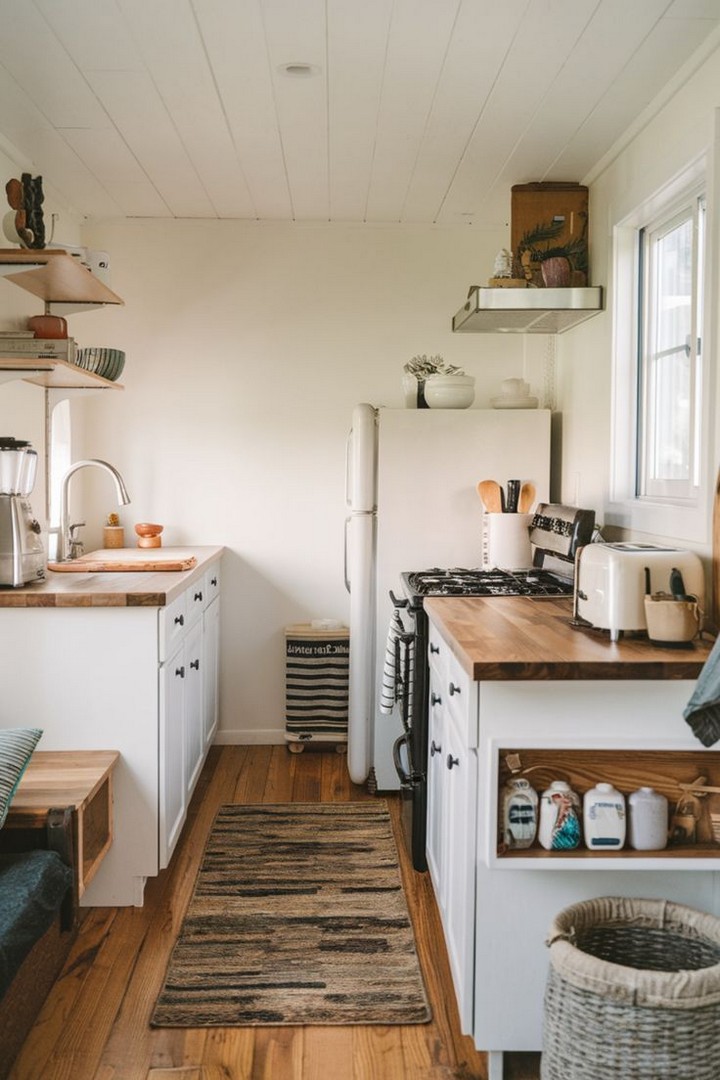
The space beneath cabinets offers valuable storage potential. Under-cabinet stemware racks hold wine glasses securely while keeping them accessible. Slide-out knife blocks utilize the often-wasted space between cabinet bottom and counter surface.
Paper towel holders, spice racks, and even small shelving units can be mounted to cabinet undersides, keeping countertops clear while maintaining easy access to everyday items. Some innovative designs include under-cabinet lighting with integrated USB charging stations, serving multiple functions in this often-overlooked space.
11. Interior Cabinet Organizers
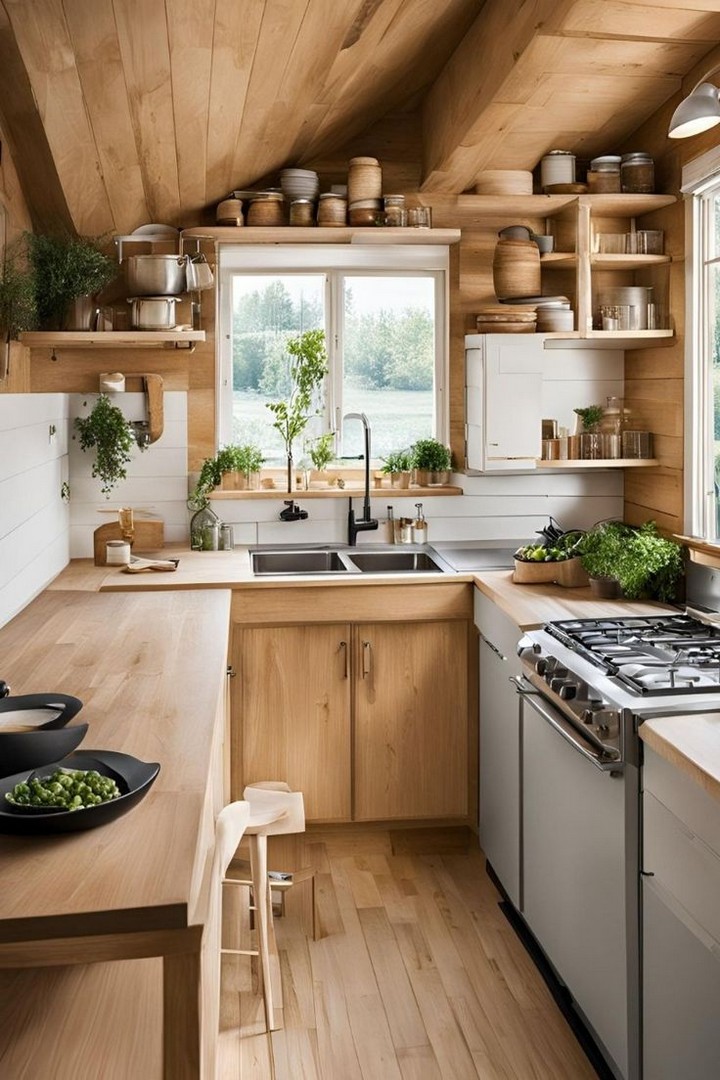
Standard cabinets waste significant space with fixed shelving. Transform cabinet interiors with pull-out drawer systems that make even deep cabinets fully accessible. Vertical dividers convert cabinets into efficient storage for baking sheets, cutting boards, and serving platters.
Door-mounted organizers utilize the interior cabinet door space for spice storage, cleaning supplies, or pot lids. Some tiny house builders incorporate custom inserts sized precisely for residents’ specific kitchen items, ensuring that every inch serves a defined purpose rather than creating dead space around irregularly shaped items.
12. Multifunctional Furniture Integration
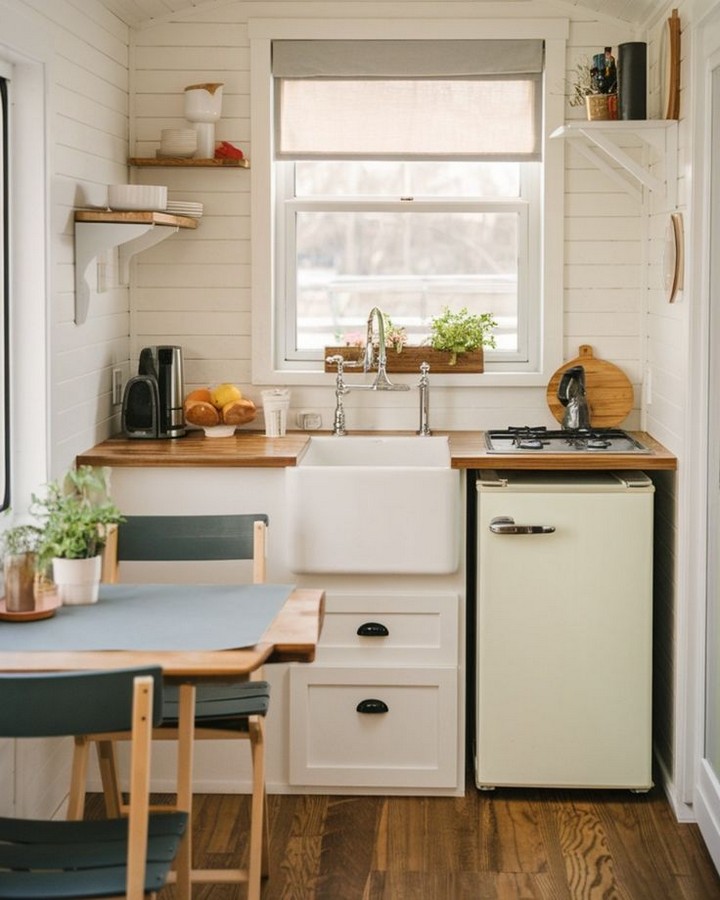
In tiny houses, kitchen storage often extends beyond traditional kitchen boundaries. Consider dining benches with hidden storage compartments for infrequently used items like special occasion serving pieces or seasonal bakeware.
Some innovative designs feature staircase storage accessible from the kitchen side, creating pantry space within the structural elements of the home. Wall-mounted tables that fold down when needed and store flat when not in use can serve as additional work surfaces during elaborate cooking projects without permanently consuming valuable floor space.
Countertop and Workspace Innovations
13. Nesting Cutting Boards
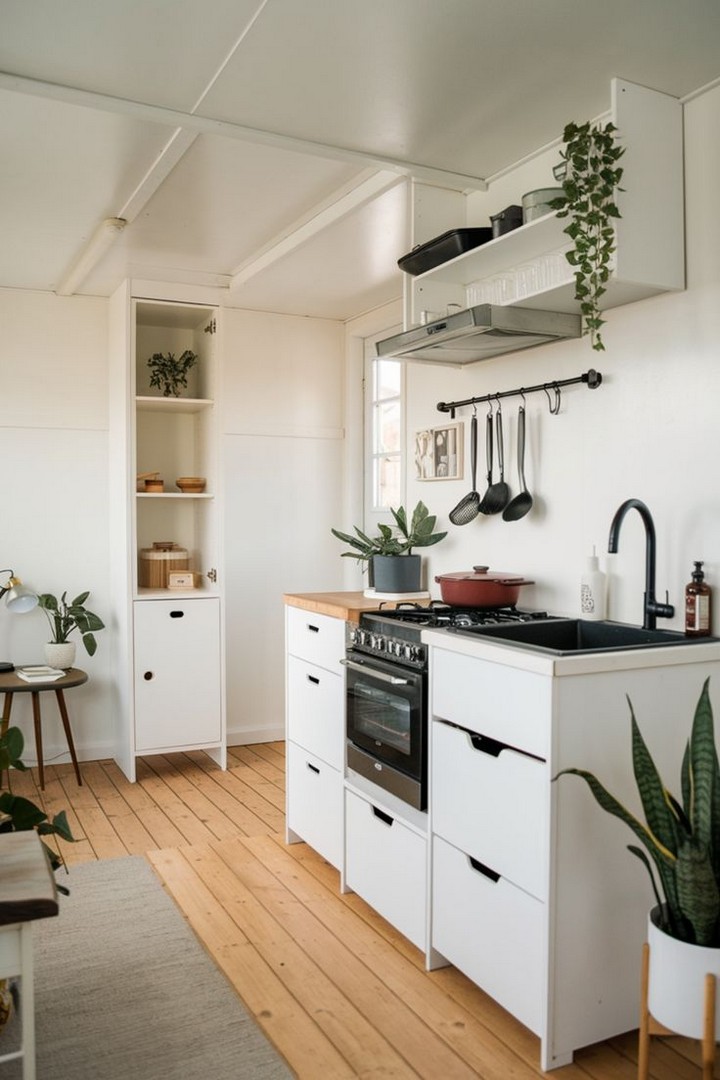
Custom-sized cutting boards that nest perfectly over sinks provide additional work surfaces without consuming permanent space. Look for models with integrated colanders or compost collection features for enhanced functionality.
For maximum versatility, some tiny house kitchens feature cutting boards with different surfaces on each side—one for meat preparation and another for vegetables—reducing cross-contamination risks while minimizing storage needs. The most innovative designs include boards that slide into custom wall slots when not in use, serving as decorative elements while remaining instantly accessible.
14. Fold-Down Work Surfaces
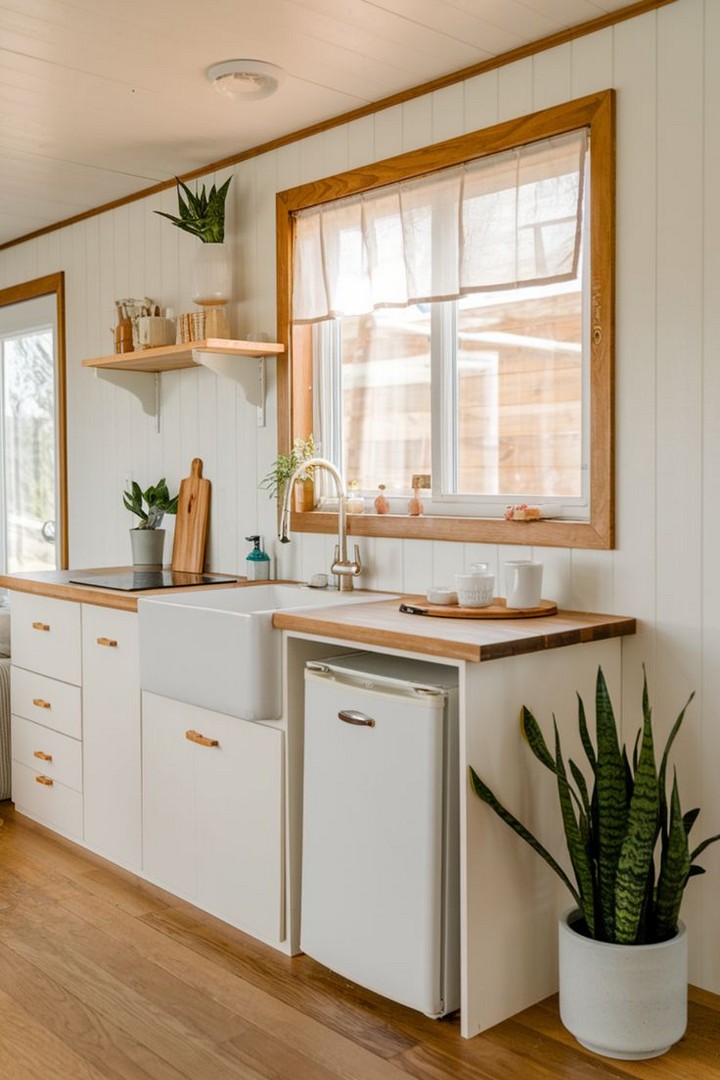
Wall-mounted countertop extensions that fold down when needed provide valuable additional prep space without permanent footprint requirements. These can be positioned strategically near cooking areas to expand functionality during meal preparation.
For enhanced utility, consider models with integrated storage that becomes accessible when the surface is deployed. Some designs feature fold-down surfaces with adjustable height settings, allowing them to serve as either standard countertops or bar-height dining areas depending on current needs.
15. Sink Covers and Convertible Basins
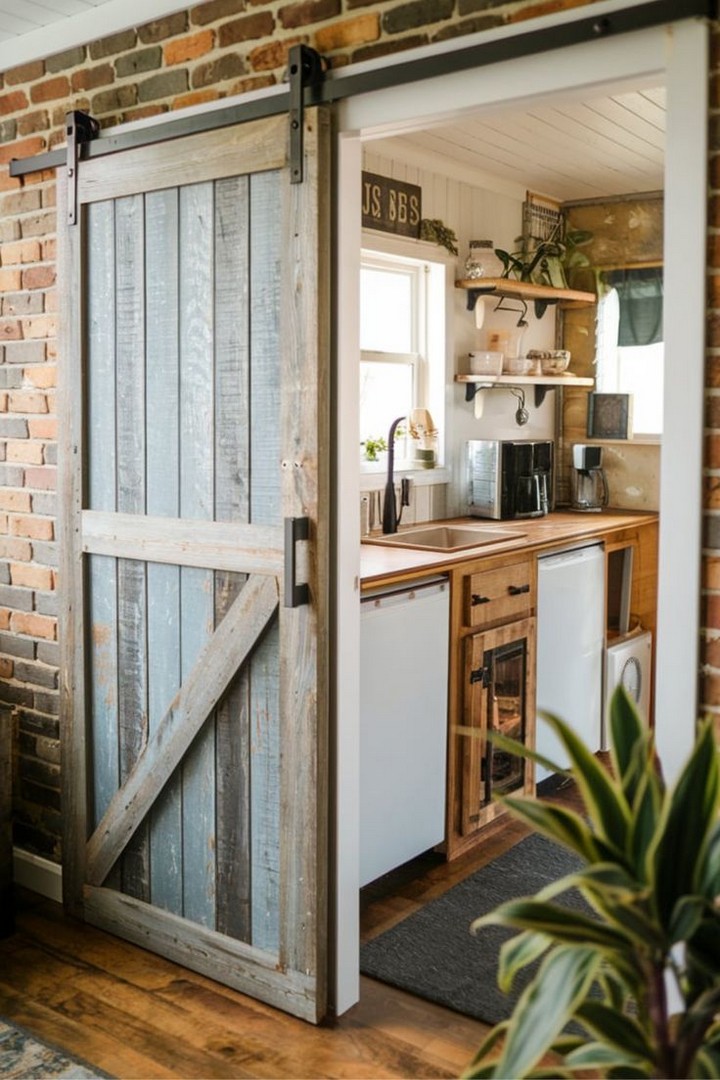
Custom-fitted sink covers instantly transform washing areas into usable workspace. Look for cutting board materials that can withstand repeated use and cleaning without warping or harboring bacteria.
For maximum flexibility, consider workstation sinks with integrated accessories like colanders, drying racks, and cutting boards that slide along tracks, creating different functional zones within the sink area. Some innovative tiny kitchens feature sinks with adjustable depth settings, conserving water during light tasks while providing sufficient capacity for larger cleaning jobs.
16. Strategic Corner Solutions
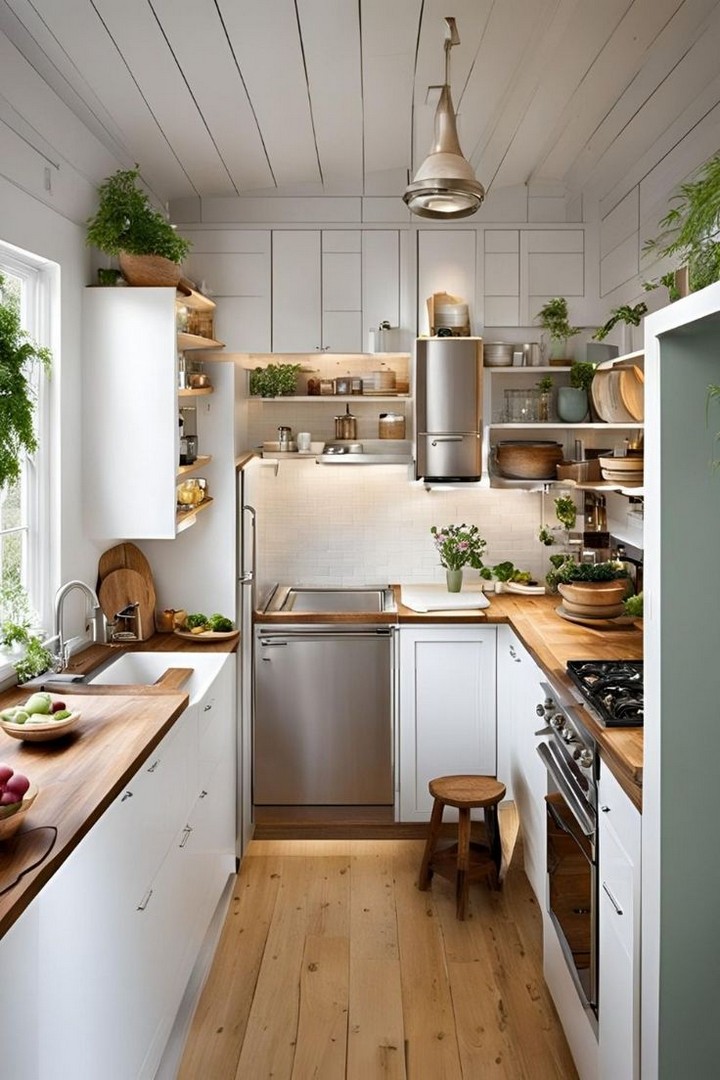
Corner spaces often become wasted in kitchen designs. Corner cutting boards that fit precisely into right-angle countertop junctions reclaim these otherwise awkward areas for functional use.
Some tiny house designers incorporate corner sinks with custom triangular basins that maximize interior capacity while minimizing exterior dimensions. Others create corner herb gardens with built-in grow lights, transforming potentially wasted spaces into productive growing areas that contribute fresh ingredients to meals.
Creative Storage Systems
17. Magnetic Organization Systems
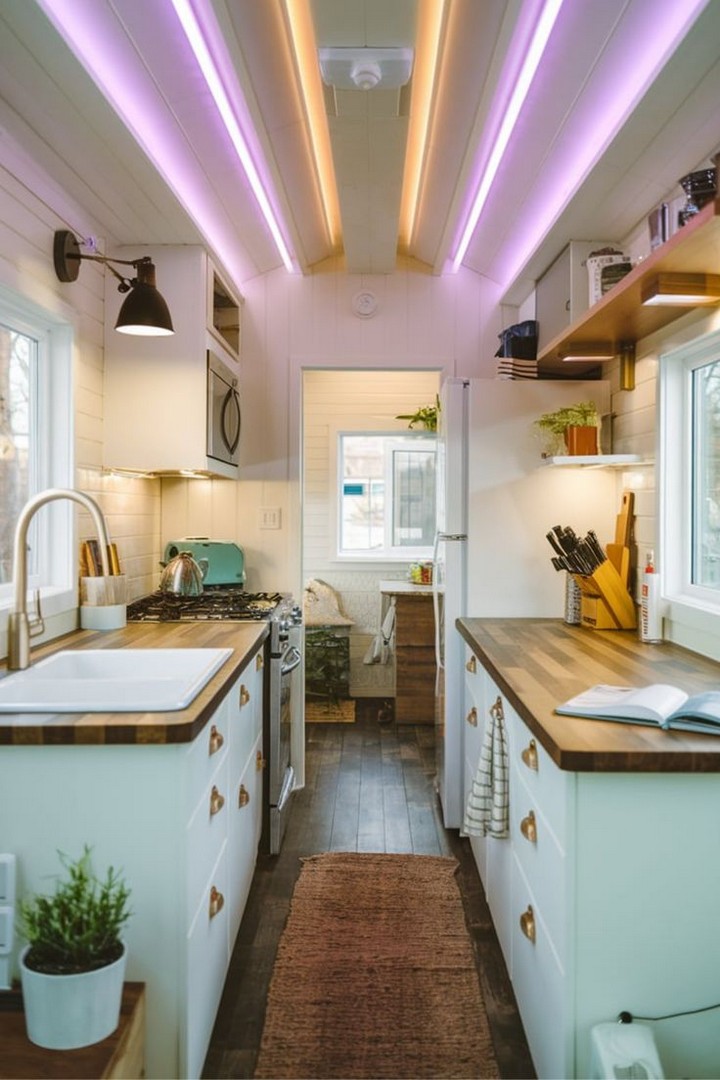
Magnetic surfaces transform unused wall spaces into functional storage. Knife strips keep cutting tools accessible while freeing drawer space. Small magnetic containers hold spices or small items that would otherwise consume valuable shelf real estate.
For maximum utility, some tiny house kitchens feature entire backsplash areas made from magnetic stainless steel or magnetic paint covered with clear sealant. These surfaces accommodate modular magnetic organizers that can be reconfigured as needs change, from spice storage to recipe holders to small tool organization.
18. Ceiling-Mounted Storage
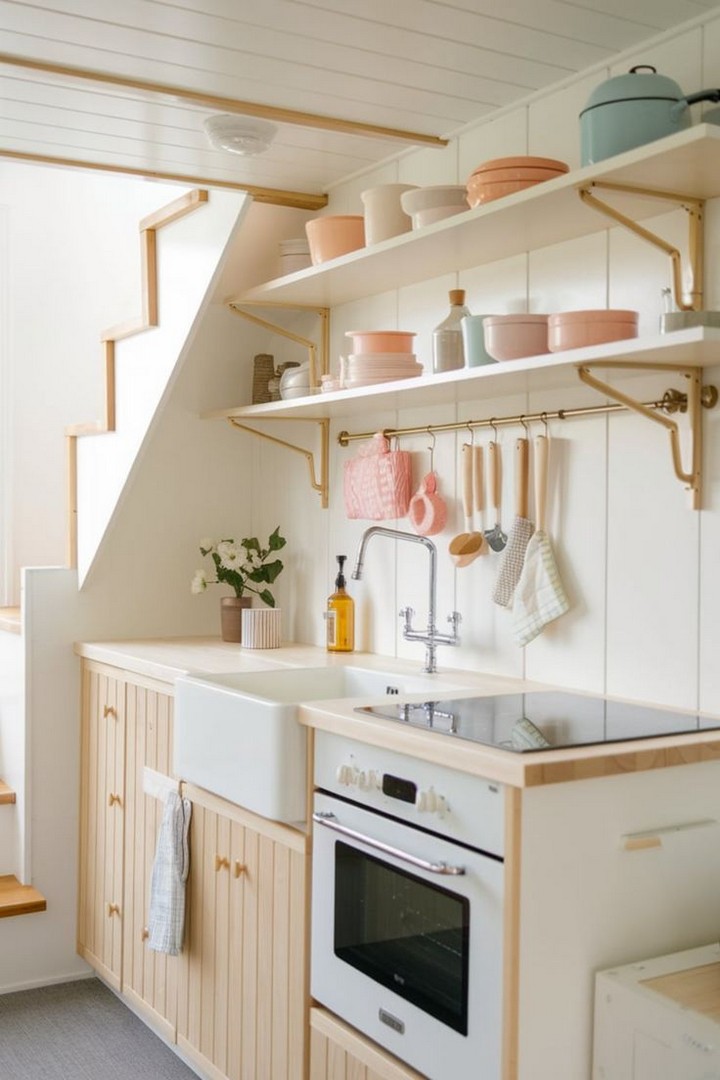
The ceiling represents untapped storage potential in many tiny kitchens. Hanging pot racks keep frequently used cookware accessible while showcasing attractive pieces. Custom ceiling grids with hooks accommodate everything from cooking utensils to hanging produce storage.
For those with higher tiny house ceilings, retractable storage systems can lower for access and raise when not needed. Some innovative designs feature ceiling tracks that allow hanging storage to slide out of the way when accessing different kitchen zones, combining accessibility with space efficiency.
19. Between-Appliance Niches
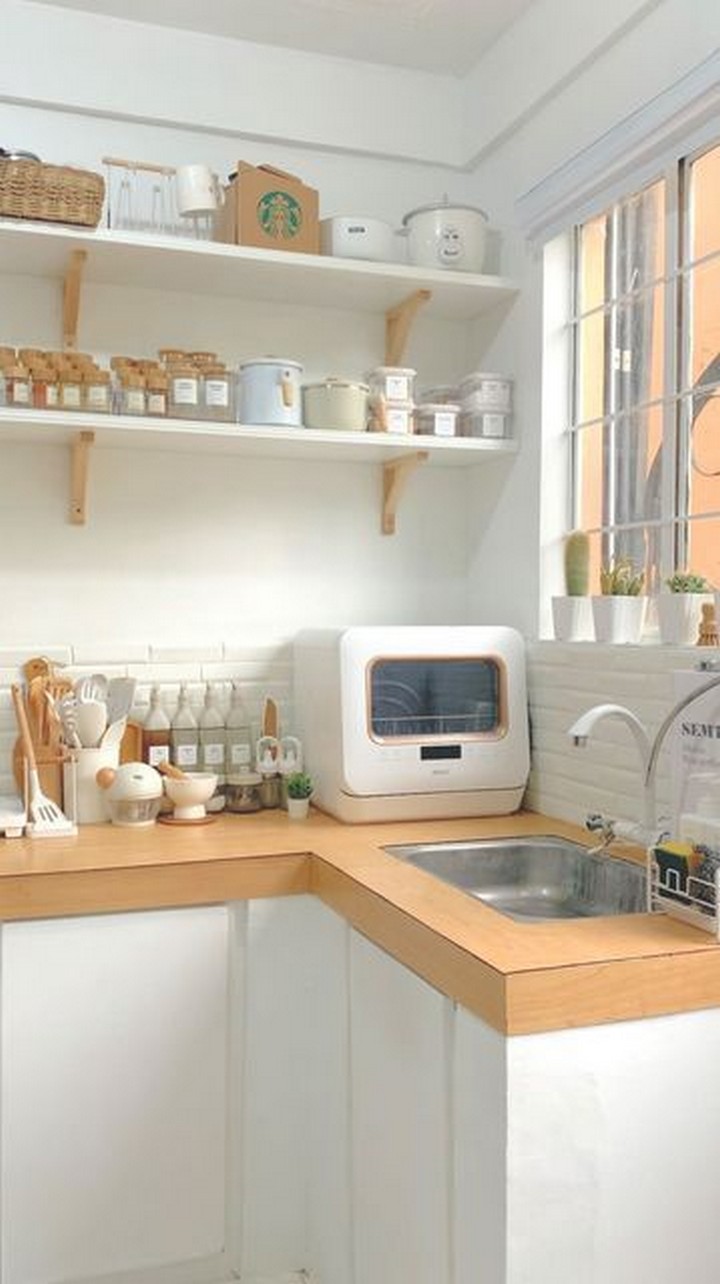
The narrow spaces between appliances often become dead zones in kitchen layouts. Vertical pull-out pantries as slim as 6 inches wide transform these gaps into highly functional storage for canned goods, spices, or baking supplies.
Some creative tiny house designs incorporate custom-built roll-out pantries sized precisely to fit available niches, with specialized storage configured for specific items like wine bottles, spice jars, or canned goods. These systems maximize storage density while keeping everything visible and accessible with a single motion.
20. Under-Floor Storage Compartments

For items used less frequently, some tiny houses incorporate storage compartments built into the floor structure. These can be particularly useful for bulk items, seasonal equipment, or special occasion serving pieces that don’t require daily access.
The most successful under-floor systems feature hydraulic lift mechanisms that make accessing this storage physically easy, transforming what could be awkward crawl spaces into highly functional storage expansions. Some designs incorporate insulated under-floor compartments that serve as natural cold storage for root vegetables or beverages.
Aesthetic Considerations
21. Reflective Surfaces for Visual Expansion
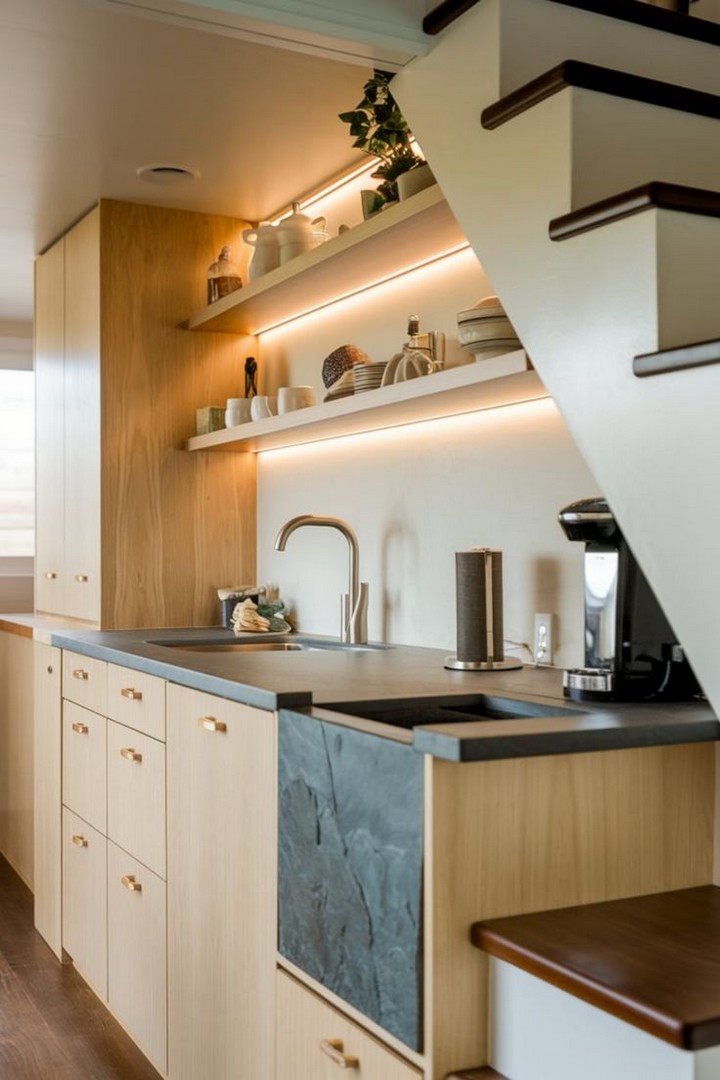
Strategic use of reflective surfaces makes tiny kitchens feel larger. Mirrored backsplashes create the illusion of doubled space while adding light and sparkle. Glass-front cabinet doors reduce visual weight compared to solid fronts.
Glossy cabinet finishes reflect light and contribute to a sense of openness. Some tiny kitchen designs incorporate stainless steel backsplashes or countertops that serve both practical and visual expansion purposes, with the added benefit of durability in high-use environments.
22. Light-Maximizing Window Placement

Natural light dramatically affects how spacious a tiny kitchen feels. When possible, position the kitchen to benefit from existing windows. Avoid blocking light sources with tall cabinetry or appliances.
For tiny houses in design phases, consider clerestory windows above kitchen areas to bring in light without sacrificing wall storage. Some innovative designs feature light tubes or small skylights positioned strategically above work areas, bringing natural illumination to interior spaces without extensive structural modifications.
23. Strategic Color Utilization
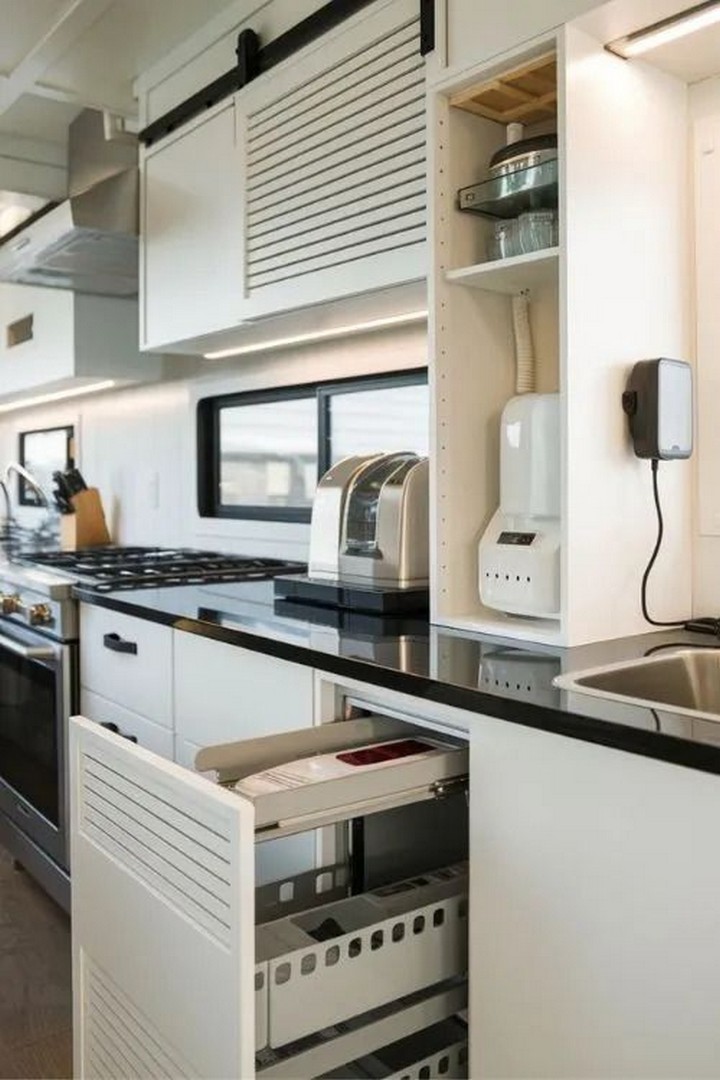
Color choices significantly impact perceived size. Light upper cabinets with slightly darker lower cabinets ground the space while maintaining airiness. Monochromatic color schemes create visual continuity that makes small spaces feel larger and more cohesive.
Pops of color in easily changeable elements like shelf liners, small appliances, or accessories add personality without permanent commitment. Some tiny houses feature color-blocked storage bins or containers that add visual interest while serving organizational purposes, proving that functional elements can also contribute to aesthetic appeal.
24. Open Shelving for Visual Breathing Room
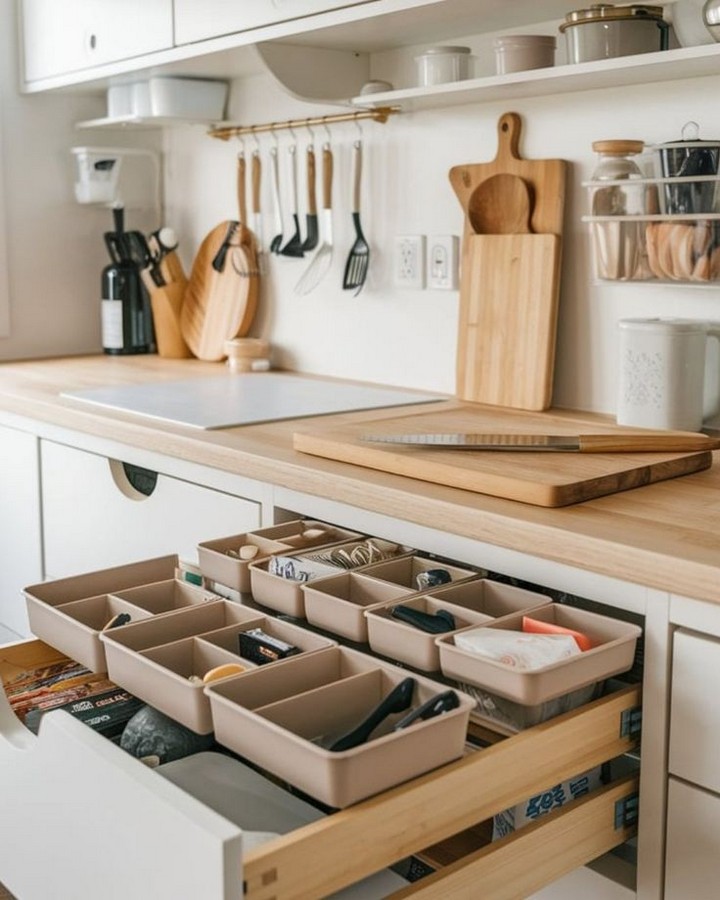
While closed storage efficiently utilizes space, strategic open shelving creates visual breathing room. Display visually appealing items like colorful dishes, glass containers of dry goods, or fresh herbs in attractive planters.
For maximum effect, limit open shelving to specific zones rather than throughout the kitchen, creating focal points that break up the potential monotony of continuous cabinetry. The most successful tiny kitchen designs feature a thoughtful balance between open and closed storage, with everyday items accessible on shelves and less attractive necessities concealed behind doors.
Practical Organization Systems
25. Categorized Container Systems
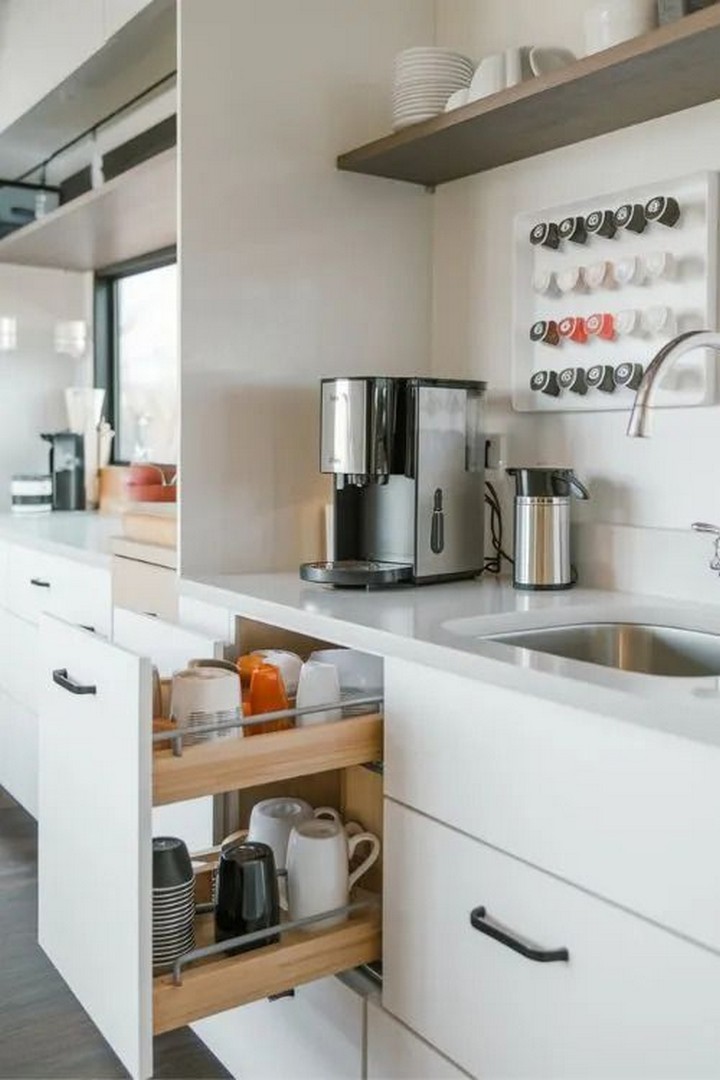
Consistent food storage containers maximize both physical and visual space. Clear containers in standardized shapes stack efficiently while allowing instant inventory assessment. Labeling systems prevent confusion and unnecessary purchases of items already on hand.
The most organized tiny house kitchens feature complete container systems where everything is visible, accessible, and logically arranged—often with similar items grouped together and stored near where they’ll be used. This thoughtful organization minimizes time spent searching for ingredients during meal preparation.
26. Adjustable Shelving Throughout
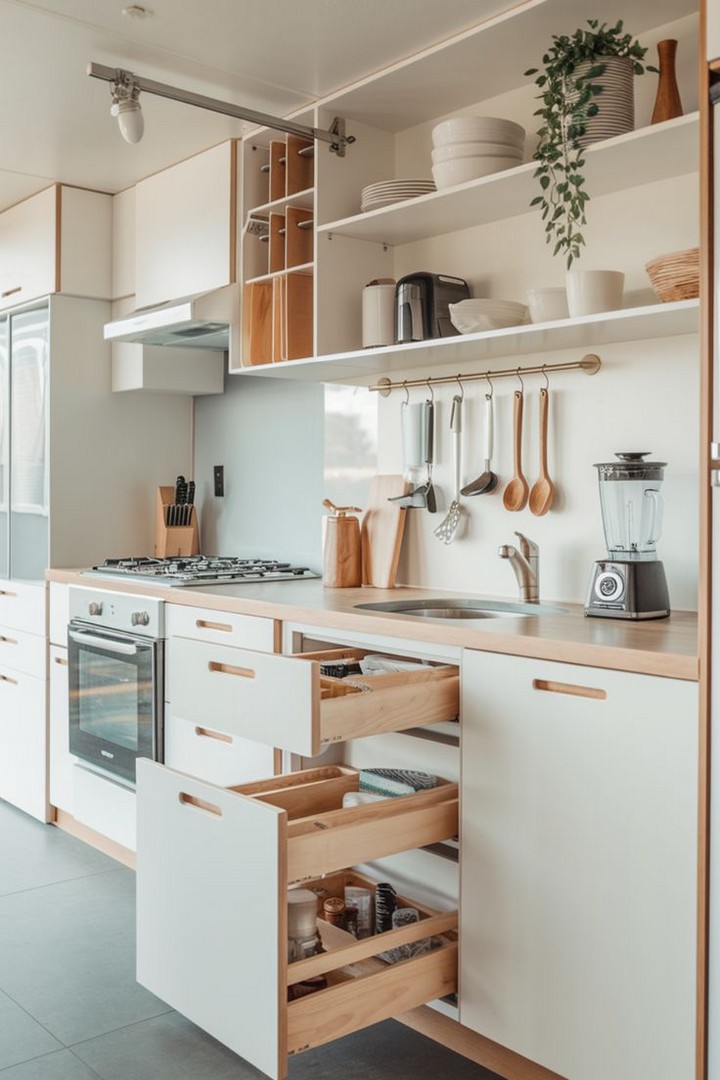
Fixed shelving inevitably creates wasted space. Adjustable systems allow configuration changes as needs evolve. Look for shelving tracks that offer fine-tuned height adjustments rather than limited preset positions.
Some innovative tiny house designs feature completely modular interior storage systems where shelves, drawers, and specialized organizers can be reconfigured without tools, allowing the space to transform based on changing needs or preferences. These adaptable systems ensure the kitchen remains optimally functional throughout years of use.
27. Door and Cabinet Back Utilization
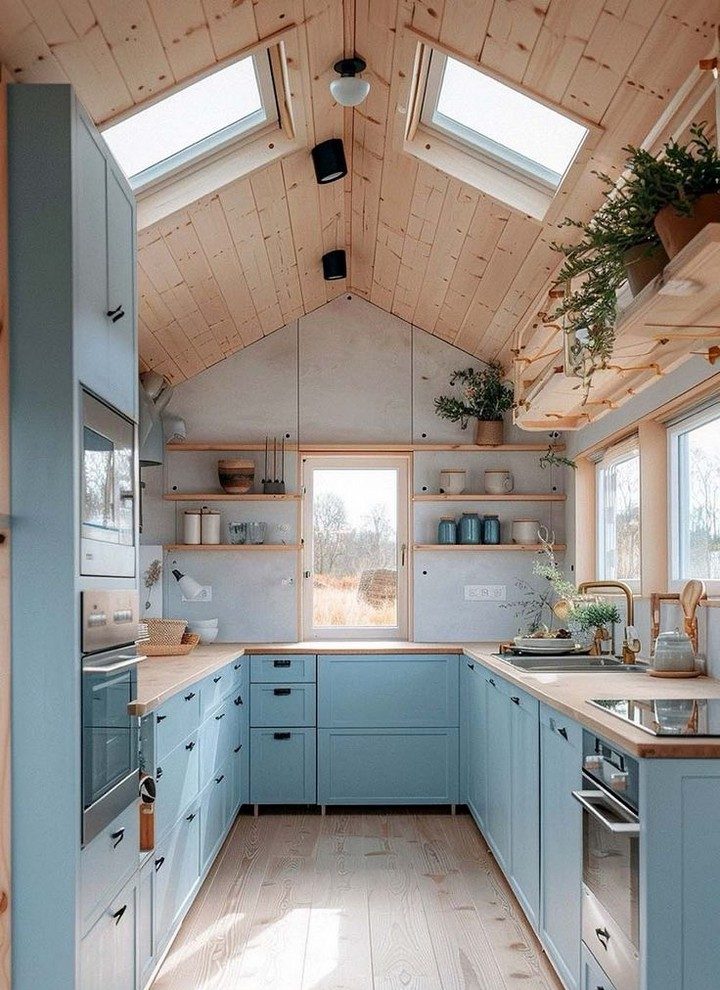
Cabinet doors and backs offer overlooked storage potential. Door-mounted spice racks, cutting board holders, or paper towel storage free up interior cabinet space for other items.
Cabinet back panels can accommodate hook systems for measuring cups and spoons, keeping these frequently used items accessible without consuming drawer space. Some tiny house builders incorporate whiteboard or chalkboard material on cabinet backs for grocery lists or frequently used conversion charts, adding practical functionality to otherwise unused surfaces.
28. Digital Organization Solutions
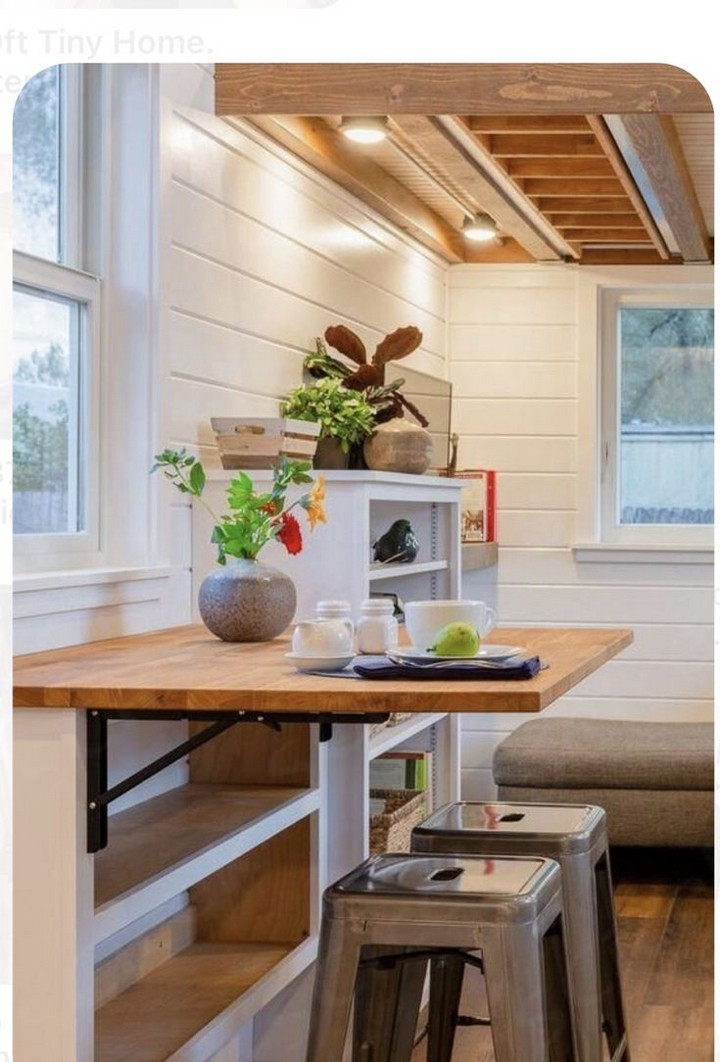
Smart technology offers valuable support for tiny kitchen organization. Digital recipe storage eliminates the need for physical cookbooks. Inventory apps help track pantry contents, reducing food waste and redundant purchases.
Voice-activated assistants provide hands-free access to recipes, measurement conversions, and cooking timers particularly valuable when working in tight quarters where counter space for reference materials is limited. Some tiny house dwellers use digital mapping of their storage systems, creating searchable databases that indicate exactly where each kitchen item is stored.
Thinking Beyond Size Limitations
The most successful tiny house kitchens transcend their physical dimensions through thoughtful design and organization. Rather than focusing on limitations, they exemplify how creativity and intention can transform even the smallest cooking spaces into highly functional culinary workshops.
Whether implementing a single idea from this collection or incorporating multiple strategies, the key lies in personalization creating a tiny kitchen that reflects your specific cooking style, storage needs, and aesthetic preferences. With careful planning and innovative solutions, compact kitchens can deliver impressive functionality without sacrificing style or cooking enjoyment.
The tiny house movement continues to demonstrate that thoughtful design trumps square footage when it comes to creating spaces that support our daily activities and aspirations. These 28 kitchen design and organization ideas prove that culinary creativity requires inspiration and innovation not endless counter space and cavernous cabinets.
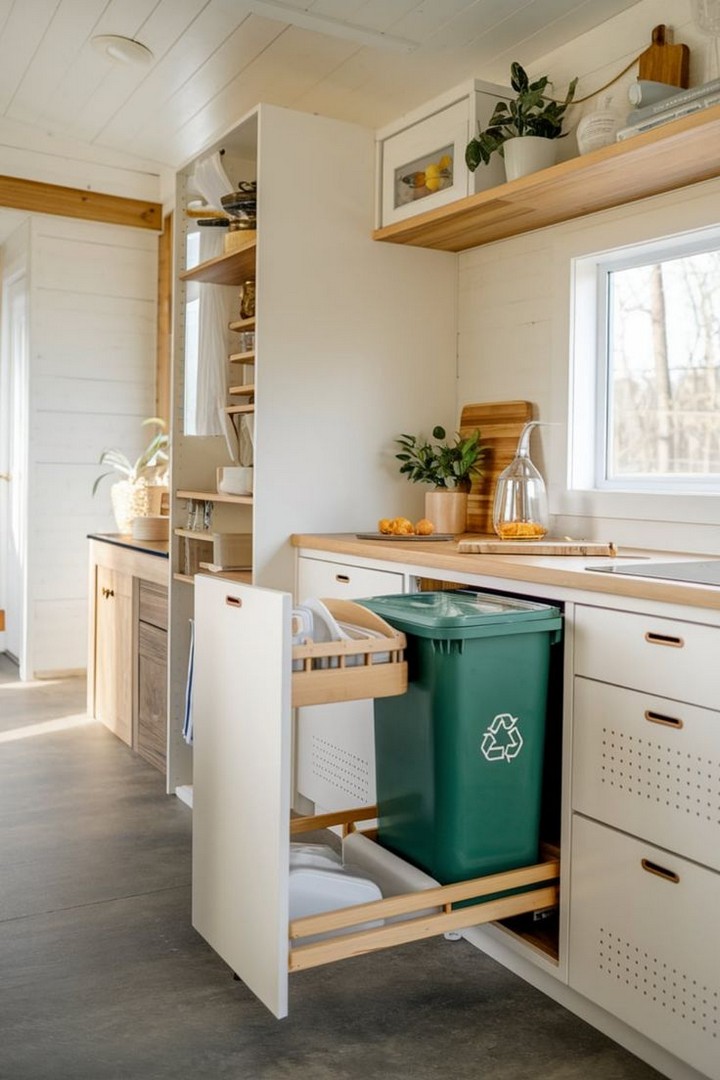
Have you implemented any space-saving strategies in your compact kitchen? We’d love to see your innovative solutions! Comments below or tag us on social media with #DecoMAGZ #TinyKitchenBigIdeas.
Planning a tiny house kitchen and have specific questions about making the most of your limited space? Ask in the comments, and our tiny living experts will provide personalized suggestions to help you create a cooking space that’s both beautiful and functional.
For more compact living inspiration, explore our related articles on tiny house bathroom designs, multipurpose furniture solutions, and small-space storage innovations!

